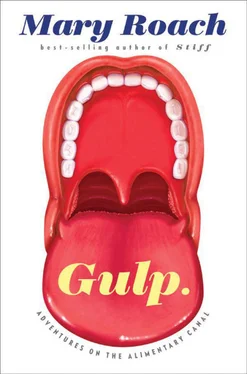When Nichopoulos’s book came out, a colorectal surgeon named Chris Lahr contacted him. Lahr’s specialty is the paralytic colon. [115] He wrote a book on the topic, called Why Can’t I Go?, which features dozens of defecography stills and close-ups of colon surgery graphic enough that the back cover has a warning. Can I Go Now?
He has excised, in part or in whole, more than two hundred of them, and he surmised that Presley had had one too. When I spoke to Lahr by phone he told me Johnny Cash, Kurt Cobain, and Tammy Wynette had also struggled with obstinate constipation, and he was convinced that they too had stretches of paralyzed colon. But these were also people who struggled with obstinate drug addictions. Opiates, whether they’re in the form of heroin or prescription painkillers, drastically slow colon motility (as do, by varying degrees, antidepressants and other psychiatric drugs).
To know which is right—whether it was drugs or genetics behind the King’s condition—you’d need some information about his childhood. Most people with Hirschsprung’s—the main cause of megacolon—are diagnosed as infants or young children. As Mike Jones put it, “They come out of the box that way.” If there were truth to the story Adrianne Noe had heard, about Presley’s mother having to use her finger on him, that would suggest a hereditary condition like Hirschsprung’s. I ask Nichopoulos whether he’d heard the business about manual disimpaction. Edna volunteers that she’d read that in one of the many Elvis biographies.
Nichopoulos says he looked into it himself. “We were trying to figure out if it was there from birth or whether it was something that came on later. But his mother was gone.” Gladys Presley died when Elvis was twenty-two. Presley’s father wasn’t around the house much when Elvis was a child.
“I wanted to talk to Priscilla about it,” he says. Presumably Elvis would have discussed his medical issues with his wife. Nichopoulos shifts his weight. The hip still causes him pain. “She didn’t want to discuss it.”
It surprises me that Presley’s condition didn’t dampen his enthusiasm for food. He so appreciated Edna Nichopoulos’s Greek hamburgers that he gave her a ring he’d commissioned, with each of the recipe’s ingredients represented by a different-color diamond. “Green for parsley,” says Nichopoulos when I ask about it, “white for the onion, brown is the hamburger, and yella…” Some words are born for the Memphis accent. Yellow is one.
“Yella is the onion,” says Edna.
Nichopoulos considers this. “Wasn’t that the white?”
“No, white’s the bread.”
“Elaine!” Nichopoulos shouts toward the upstairs. “Can you get the hamburger ring!” Elaine Nichopoulos has been living with her parents, helping out since her father broke his hip.
A few minutes pass before Elaine appears on the stairs. She crosses the living room with a crooked gait, the combined aftermath of a car crash and a fall from a ladder. “Sorry, I was in the bathroom,” she says. “I’m sure y’all can understand”— y’all meaning the freaks down in the living room talking about bowel health.
Elaine sits down on her dad’s mobility scooter. She shows me where the pins stuck out of her ankle as it healed. Then she pulls down the shoulder of her shirt. I expect more medical hardware, but it’s a tattoo. “Do you like monkeys?” I almost say, but then I get it: There’s a monkey on her back. Oxycontin, fentanyl, drugs for chronic pain. On top of everything else, she has fibromyalgia.
“…and bipolar,” her dad chimes in.
She makes a face at him. “No, you are.”
I ask permission to try on the hamburger ring. “Go ahead,” Nichopoulos says. “We’ve got finger cutters.” It’s a fabulous object. I love the mix of diamonds and hamburger, glamour and trash. I feel like Elizabeth Taylor and Larry Fortensky at the same time.
ELVIS PRESLEY’S COLON is not on display in a glass case, but you can get a good sense of what it looked like by reading the autopsy section of The Death of Elvis . “As Florendo cut, he found that this megacolon was jam-packed from the base of the descending colon all the way up and halfway across the transverse colon…. The impaction had the consistency of clay and seemed to defy Florendo’s efforts with the scissors to cut it out.”
Nichopoulos was at the autopsy and remembers the moment. The clayey material, he says, was barium, administered to prep Presley for a set of X-rays—taken four months earlier. “That barium was…” He gestures toward the fireplace. “Just like a rock.” He says the impaction obstructed at least 50 to 60 percent of the diameter of Presley’s colon.
In the 1600s, the venerable English physician Thomas Sydenham advocated horseback riding as a remedy for an impacted bowel. I mention this to Nichopoulos, noting that Presley had liked riding well enough to have had a stable built at Graceland.
“That’s interesting,” he says. “It would certainly loosen it up.” Elaine turns the scooter and drives away.
Thomas Sydenham was an uncommonly gentle practitioner. Another of his treatments for intestinal obstruction featured mint water and lemon juice, as if all that were needed to make a man right was a refreshing summertime beverage. “I order, too,” he continued, “that meanwhile a live kitten be kept continually lying on the naked belly.” The kitten was to remain in place for two to three days, whereupon a dram of something unrecognizable but presumably stronger was prescribed. “The kitten is not to be taken off before the patient begins with the pills.”
Sydenham did not explain himself. I was left wondering whether this was an early form of animal-assisted therapy and the kitten’s role was simply to help the patient relax while nature took its course. Impactions often resolve on their own. Sydenham once treated an overburdened London businessman by sending him to Edinburgh to visit a specialist who didn’t exist. The patient returned from his weeklong rail journey vexed but rested and cured.
It’s also possible, though unlikely, that the kneading of the kitten’s paws was viewed as a kind of therapeutic massage. Around the turn of the last century, massage—or medical gymnastics, as it was also then called—was not uncommonly applied to the obstructed bowel. Here is Anders Gustaf Wide, in the Hand-Book of Medical and Orthopedic Gymnastics , discussing the technique of “colon-stroking”: “One can at least feel the lower part of the larger intestine and often the hard feces in it and even feel, how, in stroking, these are carried forward in the direction they should go.”
Or not. In a 1992 University of Munich study, nine sessions of “colonic massage” failed to speed colon transit time in constipated subjects and nonconstipated controls. The subjects’ sense of well-being was monitored throughout the three weeks of treatment, and this too failed to improve. It might have gone differently had the masseuses incorporated some techniques from Anders Gustaf Wide—“anal massage,” for instance, wherein “small circular strokings are made to each side alternately with tremble-shaking round the anus.”
Surgeons, too, advocated the use of the hands to dislodge an impaction, though here it was less of a laying-on than a reaching-in. “I propose this evening to demonstrate upon the cadaver some phases of bowel exploration,” began our friend W. W. Dawson, the professor of surgery from the Medical College of Ohio, whom we met in a previous chapter. The year was 1885. Dawson introduced his assistant, Dr. Coffman, to the gathered crowd and then turned to face the examining table. “The subject, you see, is a female.” We’re going to skip ahead to item 2 on the agenda: “How far can the hand be introduced?” The “patient” was rolled on her back with the thighs raised and the knees bent. The position is known as the lithotomy position, or the missionary position, depending on whether you are taking things out or putting them in. In this case, it was a bit of both. “Dr. Coffman now introduces his hand through the anus and presses gently onward and upward.” Here Dawson invited the spectators to watch closely, because it was possible to see the bulge of Coffman’s hand moving below the body’s surface, like a cartoon mole tunneling under the lawn. “Dr. Coffman is able to move his hand with great freedom. You will recognize at once how it would be possible to dislodge… impacted feces.” [116] Vigorous debate followed, under the italicized heading “Size of the Hand.” A hand more than nine inches around is, declares Dr. Charles Kelsey, “unfit for the purpose.” Dawson counters that the size of the pelvis must be taken into consideration. “A broad hipped man or woman would admit a ten inch hand readily,” and to fix the limits lower would have the effect of “deterring and embarrassing the practitioner who happens to have a large hand.” Or four. Dawson also relates the story of a Dr. Cloquet who, “in quest of a glass tumbler,” inserted fourteen fingers into a rectum: six of his own, and four belonging to each of two colleagues. The patient’s sphincter, if not his dignity, recovered intact.
Читать дальше












